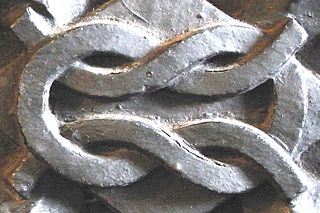
Heraldry is a discipline relating to the design, display and study of armorial bearings, as well as related disciplines, such as vexillology, together with the study of ceremony, rank and pedigree. Armory, the best-known branch of heraldry, concerns the design and transmission of the heraldic achievement. The achievement, or armorial bearings usually includes a coat of arms on a shield, helmet and crest, together with any accompanying devices, such as supporters, badges, heraldic banners and mottoes.

The figure-eight knot or figure-of-eight knot is a type of stopper knot. It is very important in both sailing and rock climbing as a method of stopping ropes from running out of retaining devices. Like the overhand knot, which will jam under strain, often requiring the rope to be cut, the figure-eight will also jam, but is usually more easily undone than the overhand knot.
The figure-eight or figure-of-eight knot is also called the Flemish knot. The name figure-of-eight knot appears in Lever's Sheet Anchor; or, a Key to Rigging. The word "of" is nowadays usually omitted. The knot is the sailor's common single-strand stopper knot and is tied in the ends of tackle falls and running rigging, unless the latter is fitted with monkey's tails. It is used about ship wherever a temporary stopper knot is required. The figure-eight is much easier to untie than the overhand, it does not have the same tendency to jam and so injure the fiber, and is larger, stronger, and equally secure.
A motto is the general motivation or intention of an individual, family, social group or organization. Mottos are usually found predominantly in written form, and may stem from long traditions of social foundations, or from significant events, such as a civil war or a revolution. A motto may be in any language, but Latin has been widely used, especially in the Western world.

The Red Rose of Lancaster was the heraldic badge adopted by the royal House of Lancaster in the 14th century. In modern times it symbolises the county of Lancashire. The exact species or cultivar which it represents is thought to be Rosa gallica officinalis.

A heraldic badge, emblem, impresa, device, or personal device worn as a badge indicates allegiance to, or the property of, an individual or family. Medieval forms are usually called a livery badge, and also a cognizance. They are para-heraldic, not necessarily using elements from the coat of arms of the person or family they represent, though many do, often taking the crest or supporters. Their use was more flexible than that of arms proper.

The Prince of Wales's feathers is the dexter heraldic badge of the Prince of Wales. It consists of three white ostrich feathers encircled by a gold coronet. A ribbon below the coronet bears the German motto Ich dien. As well as being used in royal heraldry, the badge is sometimes used to symbolise Wales, particularly in Welsh rugby union and Welsh regiments of the British Army.
The Stafford knot, more commonly known as the Staffordshire knot, is a distinctive three-looped knot that is the traditional symbol of the English county of Staffordshire and of its county town, Stafford. It is a particular representation of the simple overhand knot, the most basic knot of all.

Heraldry in Scotland, while broadly similar to that practised in England and elsewhere in western Europe, has its own distinctive features. Its heraldic executive is separate from that of the rest of the United Kingdom.

Portuguese heraldry encompasses the modern and historic traditions of heraldry in Portugal and the Portuguese Empire. Portuguese heraldry is part of the larger Iberian tradition of heraldry, one of the major schools of heraldic tradition, and grants coats of arms to individuals, cities, Portuguese colonies, and other institutions. Heraldry has been practiced in Portugal at least since the 11th century, however it only became standardized and popularized in the 16th century, during the reign of King Manuel I of Portugal, who created the first heraldic ordinances in the country. Like in other Iberian heraldic traditions, the use of quartering and augmentations of honor is highly representative of Portuguese heraldry, but unlike in any other Iberian traditions, the use of heraldic crests is highly popular.

In heraldry and vexillology, a heraldic flag is a flag containing coats of arms, heraldic badges, or other devices used for personal identification.

A Scottish crest badge is a heraldic badge worn to show allegiance to an individual or membership in a specific Scottish clan. Crest badges are commonly called "clan crests", but this is a misnomer; there is no such thing as a collective clan crest, just as there is no such thing as a clan coat of arms.

A heraldic knot is a knot, unknot, or design incorporating a knot used in European heraldry. While a given knot can be used on more than one family's achievement of arms, the family on whose coat the knot originated usually gives its name to the said knot. These knots can be used to charge shields and crests, but can also be used in badges or as standalone symbols of the families for whom they are named. The simplest of these patterns, the Bowen knot, is often referred to as the heraldic knot in symbolism and art outside of heraldry.

The Hinckaert knot, a type of decorative unknot, is a heraldic knot used primarily in Dutch heraldry. It is most notable for its appearance on the Hinckaert family heraldic badge, where a semi-angular form is used as canting arms, a common practice with heraldic badges.

The Wake knot or Ormond knot is an English heraldic knot used historically as an heraldic badge by the Wake family, lords of the manor of Bourne in Lincolnshire and also by the Butler family, Earls of Ormond.
The Dacre knot, a type of decorative unknot, is a heraldic knot used primarily in English heraldry. It is most notable for its appearance on the Dacre family heraldic badge, where its two lower dexter loops entwine a scallop, and its two lower sinister loops entwine a log.

The royal standards of England were narrow, tapering swallow-tailed heraldic flags, of considerable length, used mainly for mustering troops in battle, in pageants and at funerals, by the monarchs of England. In high favour during the Tudor period, the Royal English Standard was a flag that was of a separate design and purpose to the Royal Banner. It featured St George's Cross at its head, followed by a number of heraldic devices, a supporter, badges or crests, with a motto—but it did not bear a coat of arms. The Royal Standard changed its composition frequently from reign to reign, but retained the motto Dieu et mon droit, meaning God and my right; which was divided into two bands: Dieu et mon and Droyt.

The badge of the Royal Air Force is the heraldic emblem used to represent the RAF which features an eagle superimposed on a circlet which is surmounted by a crown.

The Bourchier knot is a variety of heraldic knot. It was used as a heraldic badge by the Bourchier family, whose earliest prominent ancestor in England was John de Bourchier, a Judge of the Common Pleas, seated at Stanstead Hall in the parish of Halstead, Essex. He was the father of Robert Bourchier, 1st Baron Bourchier (d.1349), Lord Chancellor of England. The various branches of his descendants held the titles Baron Bourchier, Count of Eu, Viscount Bourchier, Earl of Essex, Baron Berners, Baron FitzWarin and Earl of Bath. The knot should perhaps have been called the "FitzWarin knot" as according to Boutell (1864) the device was first used by the FitzWarin family, whose heir was the Bourchier family.

Heraldic badges of the Royal Air Force are the insignia of certain commands, squadrons, units, wings, groups, branches and stations within the Royal Air Force. They are also commonly known as crests, especially by serving members of the Royal Air Force, but officially they are badges. Each badge must be approved by the reigning monarch of the time, and as such will either have a King's or Queen's Crown upon the top of the badge, dependent upon which monarch granted approval and the disbandment date of the unit. The approval process involves a member of the College of Arms who acts as an advisory on all matters pertaining to the design and suitability of the insignia and motto.

The coat of arms of the Prince of Wales is the official heraldic insignia of the Prince of Wales, a title traditionally granted to the heir apparent to the reigning monarch of the United Kingdom of Great Britain and Northern Ireland, formerly the Kingdom of Great Britain and before that the Kingdom of England.


















